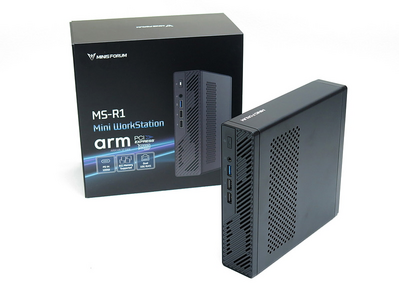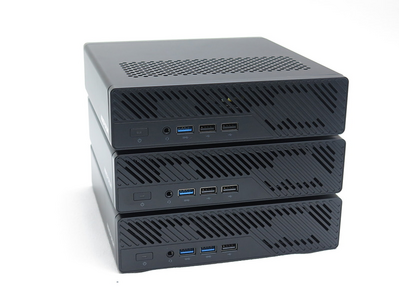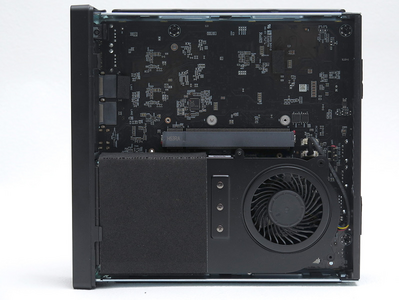Hey everyone,
I came across something really interesting from MINISFORUM that could mark a new direction for home lab enthusiasts and low-power server builders. It is the MS-R1 which is a mini PC powered by a Chinese Arm CPU from CIX Technology, officially known as the Cixin P1.
The MS-R1 features a 12-core Cixin P1 processor built on a 6 nm process, with eight Cortex-A720 performance cores and four Cortex-A520 efficiency cores. The performance cores clock between 2.3 GHz and 2.6 GHz, while the A520 cores run at 1.8 GHz. This Arm CPU also integrates an Immortalis-G720 MC10 GPU and an NPU rated for up to 30 TOPS of AI performance, making it one of the more capable Arm SoCs overall that has been in a mini PC form factor.
What’s fascinating is that the MS-R1 uses the same toolless enclosure as the MS-01 (Core i9-13900H) and MS-A2 (Ryzen 9 9955HX), bringing full server-level expandability to an Arm platform. The chassis supports USB PD 100W power, and internally it packs a PCIe 4.0 x16 slot (x8 lane active). It means it does have dGPU support. The chassis is very compact and doesn't let you have a large multi-slot GPU. However, you will be able to install a single-slot, low-power discrete GPU. This will open up a lot of possibilities for GPU compute on an Arm-based system.
Quick Specs: MINISFORUM MS-R1
| Component | Details |
|---|---|
| CPU | CIX CP8180 / Cixin P1 (Arm) – 12 cores (8x Cortex-A720 @ 2.3–2.6 GHz, 4x Cortex-A520 @ 1.8 GHz) |
| GPU | Integrated Immortalis-G720 MC10 (10 cores) |
| NPU | Up to 30 TOPS AI performance |
| Memory | LPDDR5-5500 (16GB / 32GB / 64GB), ECC variants up to ~60GB effective |
| Storage | None / 512GB / 1TB NVMe SSD |
| Networking | 2x 10GbE (Realtek RTL8127) |
| Wireless | Wi-Fi 6E, Bluetooth 5.2 |
| Ports | 2x USB 3.2 Gen2 Type-C (PD + DP Alt), 2x USB 3.2 Gen2 Type-A, 2x USB 2.0, HDMI 2.0, audio in/out |
| Expansion | PCIe 4.0 x16 slot (x8 active), supports low-profile dGPU, 40-pin GPIO, UART, eDP, I2C, TPM, BIOS pin |
| Power | USB PD 100W (20V/5A), includes 180W adapter |
| Dimensions / Weight | 196 × 189 × 48 mm / 1.35 kg |
| Operating System | Custom Debian 12 derivative (Debian 12/13 installable) |
One note from early testing is that the Realtek RTL8127 10GbE NIC does not work out of the box on Debian 12 or 13 yet. MINISFORUM has said they will release their customized Debian build and kernel configuration on GitHub soon, which is interesting. This should make it easier to get the network operating. Even with the integrated Immortalis GPU, the PCIe 4.0 slot makes this ARM PC very expandable. Once the Linux driver is available, you could install a compact NVIDIA or AMD GPU and use it for compute workloads. Also, since it has the dual 10GbE adapters this makes the MS-R1 a very powerful Arm-based mini PCs.
It will support up to 1 TB of storage and around 60 GB of LPDDR5 RAM. It will come with Wi-Fi 6E and Bluetooth 5.2. Pricing and availability of this new ARM unit have not been shared yet.
Why this matters for the home lab
Does it matter? Well I think for home lab builders, the MS-R1 could be a major step forward in bringing Arm compute into more serious home labs. Most Arm boxes on the market don't have PCIe expansion or high-speed networking. That is not the case with the R1 as it has both. With 10GbE networking, PCIe for dGPU or accelerator cards, and a capable NPU, it looks perfect for experimenting with Arm-native Docker containers. You could use it to build low-power Kubernetes clusters. Or you could even use this for testing AI inference. It could also make a great low-watt Proxmox or LXC node once Debian support is there and available.
If Minisforum can get the pricing right (which is getting a little harder now), this may be the first Arm mini PC to that has a chance to rival the x86 boxes in terms of capabilities, and I/O capability with the 10 GbE networking. It will be exciting to see how it performs once the community gets hands on it and starts running tests with Proxmox, Docker, and real-world workloads in the home lab.
Original sources:
PC Watch Article (Japanese)





